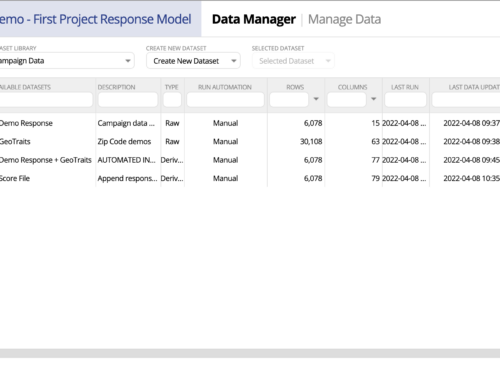Cloud based solutions open new analytic possibilities for marketing leaders in the organization of analytic data.
According to CMO.com….
- 89% of sales and marketing professionals believe data quality drives the right B2B campaigns.
- Only 11% are confident in their organizations’ data quality.
- Data must organized before shifting strategy.
Marketing AI requires standardization and merging of spreadsheet data. The key to understanding small data is understanding the difference between spreadsheets and databases. Webster’s serves as a good guiding principle. According to Webster’s, a database is ‘a structured set of data held in a computer, especially one that is accessible in various ways.’ A spreadsheet is a computer program that allows the entry, calculation, and storage of data in columns and rows. Spreadsheets are easy to use, but lack structure. Databases have great structure, but lack ease of use.
The tradeoff, for marketing decision makers is: ease of use versus long-term storage. Data is the currency that powers marketing analytics and this currency is best stored in a long-term manner. Measurement of marketing initiatives requires:
- Analyzing data over long time periods.
- Analyzing data across departments.
Martech innovators must not forget the organizational process to get to the analytics result. “Small” data such as marketing expenditures often rests in spreadsheets and needs standardized before being moved into a database. “Staging” space is incredibly important in the organization of marketing data. Think of this staging space as a clean table for your marketing measurement project. Once organized, databases are longer-term and are perfect for organizing data through multiyear periods.
Databases [data structure] does not need to be an after-thought. Here are some common barriers and solutions.
Barrier 1: Standardizing data is tough.
My analytics efforts require processing of spreadsheets and integration of various data from various sources. I need space and a software platform to organize data across various divisions and initiatives.
Getting a grip on siloed data sources requires an analyst who is willing to transform small data to big data. Analysts will need software to assist in this task. Visual interfaces have changed the landscape by helping analysts integrate data from a variety of spreadsheets. True, Excel can be used as a visual interface to merge data. However, the thought of Excel ‘vlookups’ makes most analysts cringe. According to Harvard Business Review… most office workers spend 10% of their working career “spreadsheeting.” Software platforms, like Lityx DataManager, help organizations convert unstructured spreadsheet into structured information. The structured information serves as the foundation for modeling, statistical analysis and strategic recommendations.
Barrier 2: IT is busy, so it’s best to approach IT once my analytics project is as finalized as possible.
They will be involved at the end of the analytics journey and will provide data storage and process implementation. According to CIO, IT teams are indeed busy streamlining workflows and increasing agility while minimizing distractions. Analytics leaders may lose momentum writing specifications and conforming to the work styles of IT teams.
Moving Forward: Create ‘cloud’ databases to implement new analytic projects. Look for cloud advocates on your technology teams. According to CIO… traditional IT staff focus heavily on system infrastructures and are ‘doers’ in this space. Instead, identify individuals who express interest in a combination of project analysis, business analyst and software development. Alternatively, work with an outside firm (such as Lityx) to assist in the analytic planning and cloud implementation.
Furthermore, cloud databases [such as Snowflake] do not interfere with IT existing processes and allow room for experimentation in a secure environment. “Pay-as-you-go” data storage is best for analytics. Databases have transformed from a large fixed cost to smaller marginal costs. Clients do not need to pay for servers and software licenses. Clients share resources and are only responsible for variable costs.
Conclusion
Marketing analytics leaders require flexibility and innovation. They require space to store data. Furthermore, they require data organization platforms. Cloud-based processes can be utilized for both. Software platforms, such as Lityx DataManager provide a visual interface to merge various spreadsheets together. Logic is added before merging to a centralized database. Software platforms such as Snowflake can used as long-term storage. IT departments continue to act as the central store of truth for an organization. Cloud-based platforms can help prepare that data before it reaches the destination.
Learn more about Lityx, here.
Ready to get more out of your data? Talk to an analyst to learn how Lityx can partner with you to help you assess your data management and leverage advanced analytics to improve your marketing efforts.
About Steve Ludwig:
At Lityx, Steve helps clients with a variety of marketing measurement, customer analytics and prospecting analytic initiatives. He earned his M.S. in integrated marketing from Northwestern University and has a B.S. in economics from the University of Michigan. Steve can be reached a sludwig@lityx.com.



